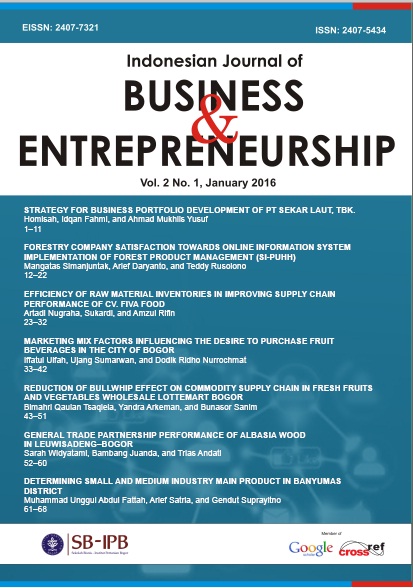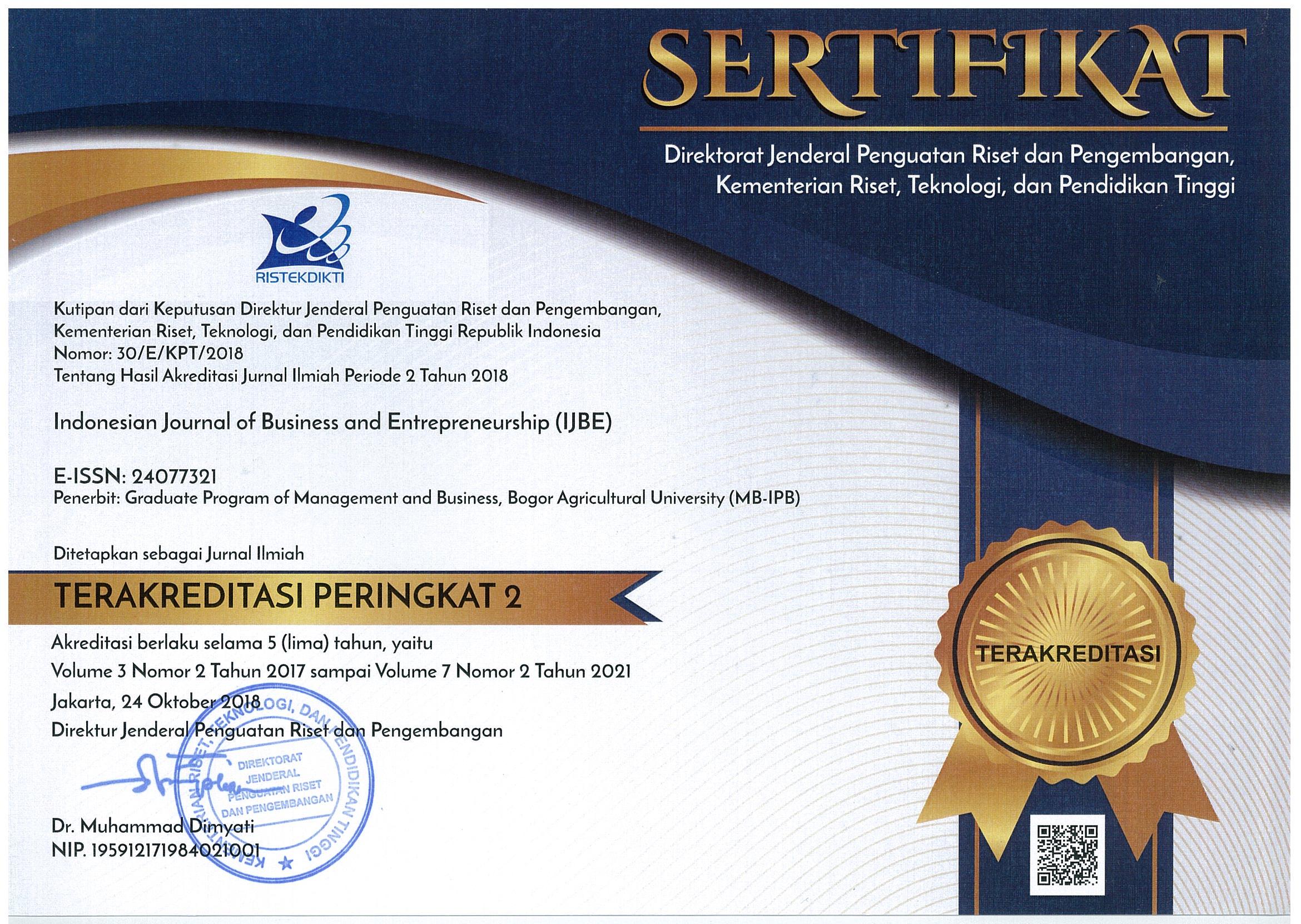EFFICIENCY OF RAW MATERIAL INVENTORIES IN IMPROVING SUPPLY CHAIN PERFORMANCE of CV. FIVA FOOD
Abstract
The production and number of processed food industries have slightly increased; as a result, the companies must compete to maximize their profits by conducting their efficient production process. CV. Fiva Food is one of the companies in the field of processed foods, especially in processed meat that has implemented supply chain management. It is necessary for the company to take measurements of its performance and efficiency for the entire supply chain such as procurement of raw materials. The purposes of this study were to analyze the performance of the company's supply chain and determine the most efficient method of procurement for its raw materials as well as and to provide recommendations for the company to improve its performance of entire supply chain. This study used SCOR in analyzing the performance of supply chain and EOQ and POQ method to be compared with the method that the company uses to determine which method of procurement for raw materials is the most efficient one. The result showed that based on the matrix, the company's performance is unfavorable when it was compared to the benchmark performance of inventory days of supply. In addition, this study showed that the POQ method produces the lowest total inventory cost with savings of Rp6.647.015 for raw materials of MDM whereas EOQ method produced the lowest total inventory cost with savings of Rp222.153,78 for raw materials of FQ85CL.Keywords: performance suppy chain, SCOR, fiva food, EOQ, POQ
Downloads
References
[AGRINA] Agribisnis Indonesia. 2014. Peluang Bisnis Manis Sosis. http://www.agrina-online.com/redesign2.php?rid=7&aid=4914.[29 Maret 2015].
[BPS] Badan Pusat Statistik. 2014. Laju Pertumbuhan PDB Triwulanan Atas Dasar Harga Konstan 2001-2014.http://www.bps.go.id/tab_sub/view.php?kat=2 &tabel=1&daftar =1&id_subyek=11¬ab=23. [1 September 2014].
Bititci US, Turner T. 2000. Dynamics of performance measurement systems. International Journal of Operations and Production Management 20(6): 692–704. http://dx.doi.org/10.1108/01443570010321676
Cagnazzo L, Taticchi P, Brun A. 2010. The role of performance measurement systems to support quality improvement initiatives at supply chain level. International Journal of Productivity and Performance Management 59(2):163–185. http://dx.doi.org/10.1108/17410401011014249
Chan F, Qi HJ. 2003. An innovative performance measurement method for supply chain management. Supply Chain Management: An International Journal 8(3):209–223.http://dx.doi.org/10.1108/13598540310484618
Chopra S, Meindl P. 2007. Supply Chain Management: Strategy, Planning, and Operation (3rd ed.). New Jersey: Pearson Education International.
Fleisch E, Tellkamp C. 2005. Inventory inaccuracy and supply chain performance: A simulation study of a retail supply chain. International Journal of Production Economics 95(3):373–385.http://dx.doi.org/10.1016/j.ijpe.2004.02.003
Gaspersz V. 1998. Production Planning and Inventory Control. Jakarta: Gramedia Pustaka Utama.
Gomes CF, Yasin MM., Lisboa JV. 2004. A literature review of manufacturing performance measures and measurement in an organizational context: a framework and direction for future research. Journal of Manufacturing Technology Management 5(6):511–530.http://dx.doi.org/10.1108/17410380410547906
Henmaidi, Heryseptemberiza. 2007. Evaluasi dan penentuan kebijakan sediaan bahan baku kantong semen tipe pasted pada PT. Semen Padang. Jurnal Optimasi Sistem Industri 6(2): 75–86.
Huan SH, Sheoran SK, Wang G. 2004. A review and analysis of Supply Chain Operations Reference Model. Supply Chain Management: An International Journal 19(1):23–29. http://dx.doi.org/10.1108/13598540410517557
Irfan D, Xiaofei X, Seng Chun D. 2008. A SCOR reference model of the supply chain management system in an enterprise. The International Arab Journal of Information Technology 5(3):287–295.
Khalid S. 2008. Trend forecasting for stability in supply chains. Journal of Business Research 61:1113–1124.http://dx.doi.org/10.1016/j.jbusres.2007.11.005
Lorentz H. 2008. Production locations for the internationalizing food industry: case study from Russia. British Food Journal 110(3):310–334. http://dx.doi.org/10.1108/00070700810858718
Maisuriya AR, Bhathawala PH. 2013. A deterministic economic order quantity model with delays in payments and price discount offers. International Journal of Engineering Research and Applications 3(5):384–385.
Mathew A. 2013. Demand forecasting for economic order quantity in inventory management. International Journal of Scientific and Research Publications 3(10):2250–3153.
Melynk SA, Stewart DM, Siwank M. 2004. Metrics and performance measurement in operation management : Dealing with metric maze. Journal of Operation Management 22: 209–217.http://dx.doi.org/10.1016/j.jom.2004.01.004
Permana HPP. 2011. Analisispengadaan bahan baku sebagai bagian dari internal supply chain management PT. Hadinata Brothers. [Tesis]. Sekolah Pascasarjana, Institut Pertanian Bogor. Bogor.
Purnamasari H. 2011. Peningkatan efisiensi manajemen rantai pasok melalui pengendalian sediaan filler dan bahan kemasan roti manis di PT. Nippon Indosari Corporindo. [Tesis]. Program Studi Magister Manajemen Agribisnis, IPB. Bogor.
Rajeev N. 2008. Inventory management in small and medium enterprises. Management Research News 31(9):659–669.http://dx.doi.org/10.1108/01409170810898554
Sidarto. 2008. Konsep pengukuran kinerja supply chain management pada sistem manufactur dengan model performance of activity dan supply chain operations reference. Jurnal Teknologi 1(1):68-77.
Tangen T. 2004. Performance measurement: from philosophy to practice. International Journal of Productivity and Performance Management 53(8):726–737.http://dx.doi.org/ 10.1108/17410400410569134
Waller MA, Nachtmann H, Hunter J. 2006. Measuring the impact of inaccurate inventory information on a retail outlet. International Journal of Logistics Management 17(3):355–376.http://dx.doi.org/10.1108/09574090610717527
William JC, Germain RN, Birou L. 2007. Variance vs average: supply chain lead-time as a predictor of financial performance. Supply Chain Management: An International Journal 12(5):349–357. http://dx.doi.org/ 10.1108/13598540710776926








